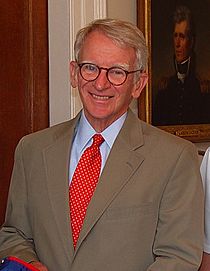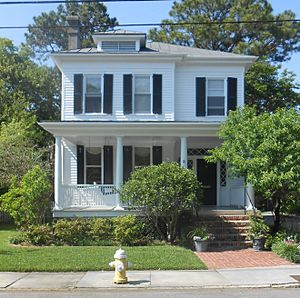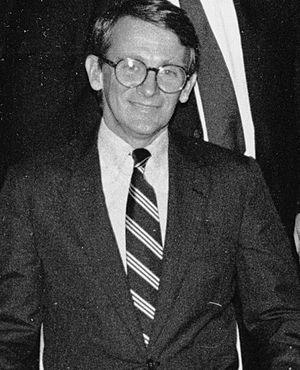Joseph P. Riley Jr. facts for kids
Quick facts for kids
Joseph P. Riley Jr.
|
|
|---|---|

Riley in 2010
|
|
| 60th Mayor of Charleston | |
| In office December 15, 1975 – January 11, 2016 |
|
| Preceded by | Arthur B. Schirmer Jr. |
| Succeeded by | John Tecklenburg |
| 44th President of the United States Conference of Mayors | |
| In office 1986–1987 |
|
| Preceded by | Ernest Morial |
| Succeeded by | Richard Berkley |
| Member of the South Carolina House of Representatives from Charleston County |
|
| In office 1968–1974 |
|
| Personal details | |
| Born |
Joseph Patrick Riley Jr.
January 19, 1943 Charleston, South Carolina, U.S. |
| Political party | Democratic |
| Spouse | Charlotte |
| Children | Joe Bratton |
| Alma mater | The Citadel (BA) University of South Carolina, Columbia (JD) |
Joseph Patrick Riley Jr. (born January 19, 1943) is an American politician. He served as the 60th mayor of Charleston, South Carolina for a very long time, from 1975 to 2016. He is a member of the Democratic Party. Before becoming mayor, he was part of the South Carolina House of Representatives from 1968 to 1974. He also led the United States Conference of Mayors from 1986 to 1987. Mr. Riley's 40 years as mayor were the longest in Charleston's history and the longest in South Carolina at the time he retired.
Contents
Early Life and Education
Joseph P. Riley Jr. was born in Charleston, South Carolina. He went to The Citadel and graduated in 1964. Later, he studied law at the University of South Carolina School of Law, finishing in 1967. He started his political career as a member of the Democratic Party. He served in the South Carolina House of Representatives from 1968 to 1974.
Mayor of Charleston
In December 1975, Joseph Riley was elected as the mayor of Charleston. He was the second Irish Catholic person to hold this important job. He served for 10 terms, which is a very long time! For example, in November 1999, he won his seventh term with 71% of the votes. In November 2003, he won his eighth term with 57% of the votes.
One important event during his time as mayor involved the Confederate battle flag. This flag used to fly above the South Carolina State House. Mr. Riley organized a five-day protest walk from Charleston to Columbia to ask for its removal. The march started on April 2, 2000, with many people joining. The Confederate flag was finally removed from the South Carolina State House on July 10, 2015. This happened after a sad event known as the Charleston church shooting.
City Development and Growth
Mayor Riley focused a lot on making Charleston a better place. He worked on many projects to help the city grow and improve.
Expanding the City
During his time as mayor, Charleston grew a lot by adding new areas, piece by piece. This process is called annexation. One of the biggest annexations was Daniel Island in 1990. Other areas added included Cainhoy Plantation and Long Savannah.
Charleston Place Project
One of Mayor Riley's first big projects was to improve the main business area of the city. In 1977, a study suggested building a large hotel, shops, and a conference center. This project was first called "Charleston Center." It was a big plan, and some people worried about how large the building would be. After some changes and legal steps, construction began in 1981. The plans were updated in 1983 to make the building fit better with the city's look. When the first developer couldn't get enough money, the city found new supporters and renamed it "Charleston Place." This important center opened on September 2, 1986.
Other Important Projects
In 1987, Mayor Riley supported other projects to help the city. These included a visitor center on Meeting Street and the Waterfront Park along the Cooper River. He helped the city buy the land for Waterfront Park at a good price.
Mayor Riley also considered the International African American Museum his most important work as mayor. This museum is being built on the site of Gadsden's Wharf. This was a place where many enslaved Africans first arrived in the United States. Construction for this important museum began in January 2020.
Responding to Challenges
Sofa Super Store Fire
In 2007, a terrible fire happened at the Sofa Super Store in Charleston. Nine Charleston firefighters lost their lives when the building's roof collapsed. After this sad event, Mayor Riley quickly put together a group of experts to investigate what happened. This group suggested many changes to the fire department to make it safer. The city of Charleston later bought the land where the store was and turned it into a quiet park.
Mother Emanuel Church Shooting
On June 17, 2015, Charleston faced a very sad event known as the Charleston church shooting. Mayor Riley was friends with some of the victims, including state senator Clementa C. Pinckney. He arrived at the scene soon after the police chief called him. After the shooting, Mayor Riley spoke about the tragedy. He said that "nine beautiful, loving people" were killed. He also spoke about the need for stricter gun control laws.
Dealing with Sea Level Rise
Charleston is a coastal city, and over the years, it has experienced more flooding from extreme weather events like hurricanes. This increase in flooding is partly due to global warming and sea level rise. Mayor Riley worked to create programs to manage flooding. Just before he left office, he released a plan to deal with rising sea levels.
Other Activities
From 1986 to 1987, Mayor Riley was the president of the U.S. Conference of Mayors. He also started the Mayors' Institute on City Design, which helps city leaders learn about good city planning. In 1994, he ran for Governor of South Carolina.
Mr. Riley is also a member of the Mayors Against Illegal Guns Coalition. This group works to make communities safer by helping to remove illegal guns from the streets.
Awards and Recognition
Joseph P. Riley Jr. has received many awards for his work and leadership:
- Outstanding Mayors Award by the National Urban Coalition (1983)
- Distinguished Citizen Award by the National Association of Realtors
- South Carolina's Order of the Palmetto
- South Carolinian of the Year
- Verner Award by the South Carolina Arts Commission (1982)
- Municipal Leader of the Year by American City & County (1991)
- Thomas Jefferson Award from the American Institute of Architects for Public Architecture (1994)
- Seaside Prize from the Seaside Institute (1997)
- President's Award from the U. S. Conference of Mayors, for outstanding leadership (2000)
- Urban Land Institute J. C. Nichols Prize for Visionary Urban Development (2000)
- Named one of the twenty-five most dynamic mayors in America by Newsweek Magazine (1996)
- Recipient of The National Medal of Arts (2009) – Presented by President Barack Obama
See also



